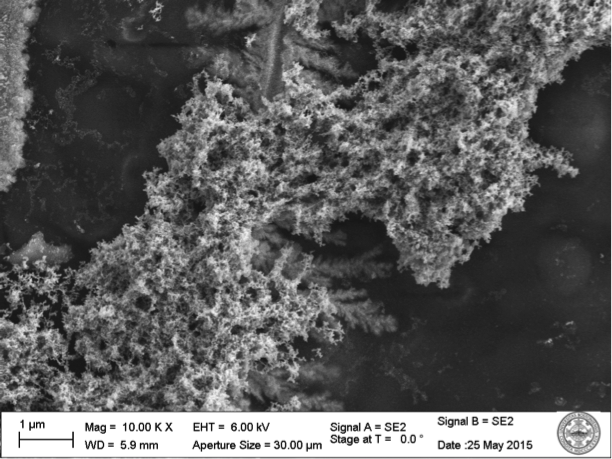Research
Research in the EME2Lab sits at the nexus of energy and the environment. We have two overarching goals: (1) identify both short and long-term solutions to the world’s energy needs, and (2) understand and mitigate the impact of energy generation processes on the environment. We have a variety of on-going projects in the lab, incorporating undergraduate, graduate and post-doctoral researchers that look at many facets of energy and its impact on the environment. To implement this vision, our research falls into three main areas:
- Energy’s Environmental Impact: Identifying the environmental impacts and unintended consequences of past and future energy generation;
- Alternative Energy Sources: Investigating economically viable and environmentally sustainable alternative energy sources, for both the short and long-range future;
- Sustainable Materials: Developing materials sourced from renewable precursors and greener processes for pollutant remediation and energy applications.
Re-engineering the Biorefinery
Biomass as a Fuel Source and Nanotemplate
This project marries two seemingly disparate fields – production of renewable fuels from biomass and fabrication of novel metal oxide nanoparticles – in a simultaneous process. By impregnating biomass with inorganic compounds, followed by heat treatment, we recover syngas, bio-oil, and bio-templated nanoparticles with unique structures and properties. The inorganic compounds act as a catalyst to improve the stability of the bio-oil. The biomass serves as a removable template for nanoparticle growth, creating structures with higher surface areas and properties mimicking nature. This co-production of energy and materials opens new possibilities in the biorefinery concept, not only to capture energy from renewables such as biomass, but also to produce nanomaterials for a range of applications in a more sustainable way.
Efficient Designs for Efficient Materials
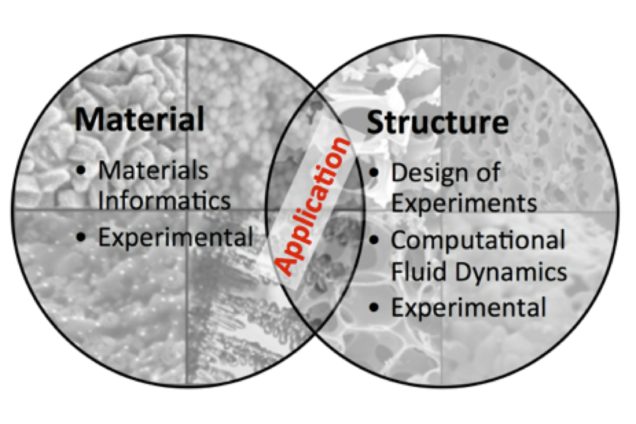
Combined materials and structural design approach for the design of heterogeneous hierarchical materials guided by application performance metrics.
Systematic Design of Porous Heterogeneous Hierarchical Materials and Structures to Optimize Reactive Transport Processes
Porous heterogeneous hierarchical engineered materials have a ubiquitous presence across applications as varied as antibacterial agents for biomedical applications, catalysts for fuel upgrading, sorbents for CO2, photocatalysts for H2O treatment, and electrodes for Li-ion batteries. These materials comprise an organic and/or inorganic scaffold designed with multiple levels and distributions of porosities, tortuosities and particle sizes, which are decorated with active sites (often nanoscale inorganic compounds) that can be incorporated during or after “construction” of the scaffold. Despite the myriad of discrete applications, a new integrated computational-experimental approach to the design of these materials that combines materials design with structural design (Fig. 1), would force a paradigm shift across these disparate fields. In a new approach to the design of materials, we will work with Prof. Emily Ryan’s group and Prof. Pirooz Vakili’s group to develop a systematic process to design, test, and validate porous heterogeneous hierarchical materials for renewable fuel upgrading.This project is supported by the National Science Foundation.
Emerging Contaminants, Emerging Concern
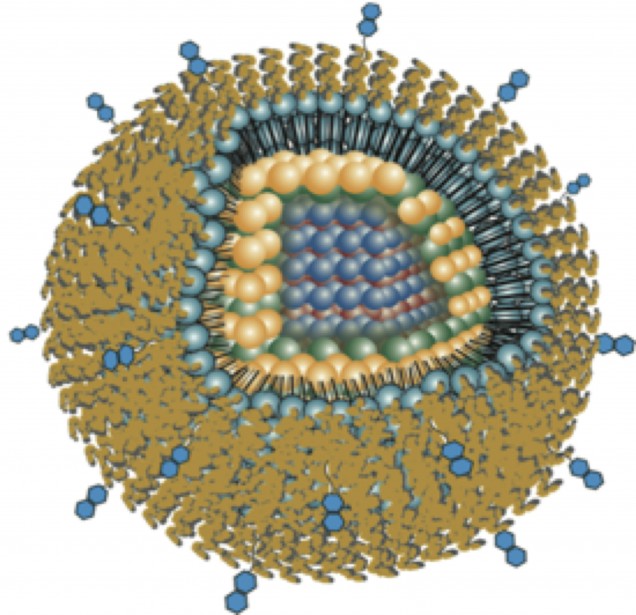
Quantum Dot: semiconductor nanocrystalline core surrounded by inorganic shell of another semiconductor. (Image courtesy Evident Technologies.)
Environmental Fate and Transport of Quantum Dots
As engineered nanomaterials such as semiconductor quantum dots (QDs) become widely implemented in consumer devices, it is critical to understand how QDs will interact with the environment. With Prof. Allison Dennis’ Lab, we are establishing techniques for evaluating the interactions between QDs and the environment, and developing a framework to categorize nanoparticle sub-types based on their organic coating to establish how surface chemistry impacts particle-media interactions, degradation, and environmental fate. This project is supported by the National Science Foundation.
Cleaning Water with Waste
Landfill and Leachate Management via Waste-to-Energy Conversions of Municipal Solid Waste
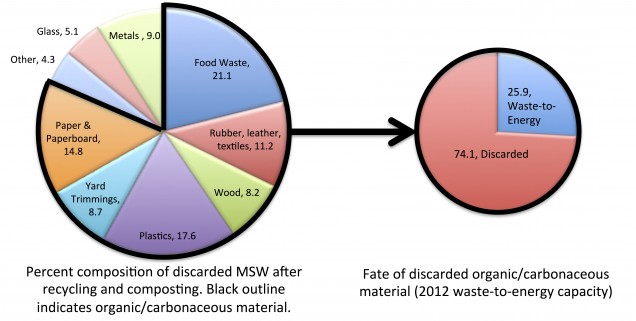
Of the 164 million tons of MSW (post-recycled) landfilled in the US each year, 80% is carbonaceous, yet only one quarter of this organic waste is used in waste-to-energy production
Engineering a long-term solution to municipal solid waste (MSW) management requires efficient, cost-effective strategies integrating waste-to-energy and waste-to-byproduct conversions of organic waste with leachate management. In MA, CT, VT and MD, new regulations may make landfilling of organic waste illegal – as such, finding a solution to organic MSW management is critical from an environmental and policy standpoint. This, combined with increasingly stringent regulations and the environmental impacts of leachate discharge, are over-burdening the MSW industry, and require an economic, efficient solution. The goal of this project, funded by the Boston University Initiative on Cities, is to design an integrated process that pyrolyzes organic waste, producing activated carbons and energy, to treat leachate via evaporation and adsorption.
A Less-is-More Approach to Biofuels
Analyzing Activation Energy Models to Improve Conversion of Biomass to Biofuels
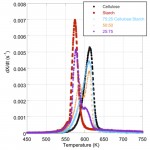
Derivative thermogravimetric curves of cellulose, starch and blends pyrolyzed at 10K/min
One of the most critical areas to shift our dependence from fossil fuels to renewable fuels is in energy for transportation. One of the challenges facing the sustainable production of renewable energy sources such as biomass is to develop an understanding of the thermodynamics and reaction kinetics when biomass is thermochemically converted to biofuel. Using a continuous distribution approach, we are developing an activation energy model for the thermal treatment of solid fuels that maximizes bio-oil yield while minimizing energy required. We are exploring ways to improve conversions by exploiting potential reaction synergies between different solid fuels. A portion of this work is supported by the National Science Foundation.
Alternatives to Waste for Alternative Fossil Fuels
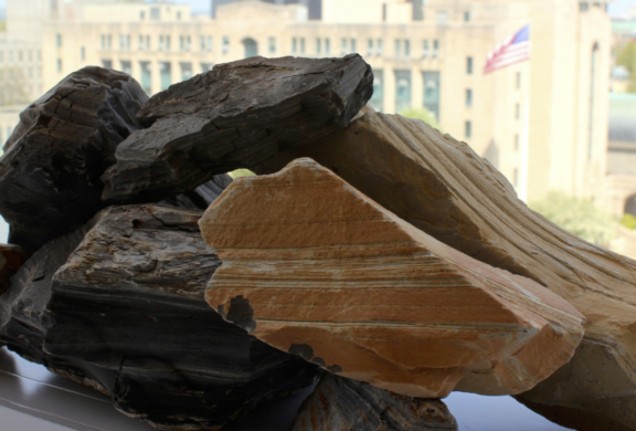
White River Mine Oil Shale
Improving Oil Shale’s Viability via Conversion of Semicoke to Adsorbents and Zeolites
Over the past several decades, concerns over dwindling fossil fuel resources have prompted a surge in research and development of alternative energy technologies, including oil shale, an unconventional fossil fuel. The primary byproduct of oil extraction is semicoke, a semi-carbonaceous material that presents environmental challenges for its disposal, yet could be transformed into a series of high-value byproducts, including sorbents and zeolites. In a new approach to waste-to-byproduct conversion, we are working with Prof. Emily Ryan’s group to enable rapid insertion of such sorbent materials into engineering systems to learn to tailor the material properties to specific uses, such as flue gas adsorption of PAH, and to scale up the processes to commercial scale. We combine an experimental approach with computational modeling to shift the paradigm of material development from production and then application assessment to a continuous design process where information concerning the end use of the material is used to tune the production of the material itself.
